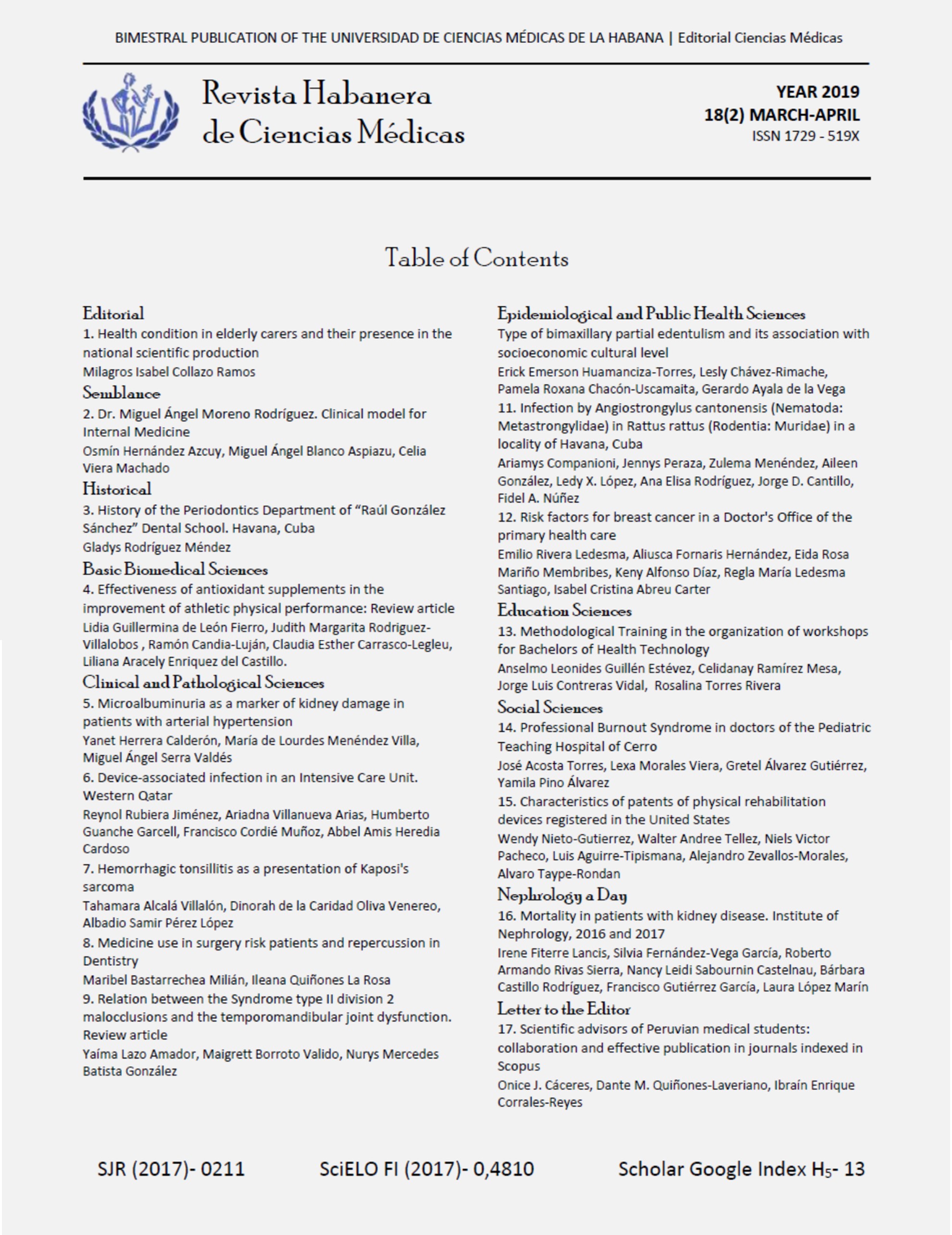Professional Burnout Syndrome in doctors of the Pediatric Teaching Hospital of Cerro
Keywords:
Síndrome de desgaste profesional, trabajadores de la salud, estrés laboral, Agotamiento emocional, Maslach Burnout Inventory.Abstract
Introduction: Professional Burnout Syndrome is a response to chronic work stress, which results from the failure of the strategies to treat these situations.
Objective: To determine the frequency of Professional Burnout Syndrome and the behaviour of its three components in the doctors of the Pediatric Teaching Hospital of Cerro.
Material and method: A descriptive, cross-sectional study was carried out in a sample of 45 doctors from a universe of 65 professionals who worked during the month of March 2018. Maslach Burnout Inventory-General Survey (MBI-GS) was used. They were classified as presenting Professional Burnout Syndrome when the three sections had very high figures. The individuals that demonstrated to have low degrees were classified as not prone to the syndrome; those that reached an average degree in some dimension were considered moderately prone; the ones that showed a high degree as well as other groups with average and low degrees were assessed as highly prone to presenting the aforementioned syndrome. Simple proportions and central tendency measures were used for the analysis.
Results: A 100% of answers were obtained; 6.7% of those evaluated presented Professional Burnout Syndrome; 31.1% were evaluated as not prone. The rest of the population showed to be moderately prone (26.6%) and a 35.5% was considered highly prone.
Conclusions: It is important to take into account and evaluate the existence of this syndrome which, although it demonstrates to have a low frequency, it shows a great potential danger of developing the syndrome in more than half of the population studied.
Keywords: Professional burnout syndrome, exhaustion, health workers, occupational stress, Maslach Burnout, Inventory.
Downloads
References
1. Maslach C, Schaufeli W, Leiter M. Job burnout. Annualreview of psychology. 2001;52(1):397-422.
2. Acosta Torres J, Balado Sansón R, Sardiña Arce M, Consuegra Otero A. Síndrome de Burnout en estudiantes internos de Medicina durante su estancia por Pediatría. Hospital Pediátrico del Cerro. Panorama Cuba y Salud 2016;11(2):43-8.
3. Morín Apela V. Desgaste Profesional en Médicos Pediatras. Biomedicina| 2014;9 (1):6-15.
4. González García N, Suárez Rodríguez K, Loredo Abdalá A. Síndrome de desgaste laboral (burnout). ¿Un riesgo para profesionales que atienden el problema de maltrato infantil? Acta Pediátrica de México 2011; 32(1):33-7.
5. Puertas Ríos A, García Atuié J, Rosete Martínez V. Síndrome de burnout (quemado) en médicos residentes adscritos a hospitales del Grupo Ángeles: HA Clínica Londres, HA Lomas, HA Metropolitano, HA México, HA Mocel y HA Pedregal. Acta Médica Grupo Ángeles. 2015; 13(2):69.
6. Chew FS, Mulcahy MJ, Porrino JA, Mulcahy H, Relyea-Chew A. Prevalence of burnoutamongmusculoskeletalradiologists. SkeletalRadiol. 2017;46(4):497-506.
7. Aranda Beltran C, Pando Moreno M, Torres López T, Salazar Estrada J, Alderete Rodríguez M. Sindrome de burnout y manifestaciones clínicas en los médicos familiares que laboran en una institución de salud para los trabajadores del estado. Psicología y Salud. 2006; 16(1):15-21.
8. Zanatta AB, Lucca SR. Prevalence of Burnout syndrome in health professionals of an onco-hematological pediatric hospital. Revista da Escola de Enfermagem da USP. 2015; 49(2).
9. Terrones Rodríguez JF, Cisneros Pérez V, Arreola Rocha JJ. Burnout syndrome in medical residents at the General Hospital of Durango, México. RevMedInstMex Seguro Soc 2016;54(2):342-6.
10. Tantaleán Da Fieno J. Burnout (desgaste profesional) en el pediatra. Rev Perú Pediatr 2008;61(4).
11. Vergara JP, Abello I, Salgado S, Becerra P. Percepción de la calidad de vida de los médicos residentes de neurología y neuropediatría en Colombia. Acta Neurológica Colombiana. 2015; 31(3):350-5.
12. Ordenes N. Prevalencia de Burnout en trabajadores del hospital Roberto del Río. RevChilPediatr 2004;75 (5):449-54.
13. Alfonso Sarría J, Sandoval Ferrer S, Prado Rodríguez R, Carbonell Estacholi C. Síndrome de Desgaste Profesional en médicos que atienden urgencias. Hospital Universitario Calixto García, 2010-2012 Revista del Hospital Psiquiátrico de La Habana. 2014; 11(3).
14. Hernández Gómez LC, Hernández Meléndrez DE, Bayarre Vea HD. La autoestima como variable moduladora del desgaste profesional en especialistas en Medicina General Integral. Revista Cubana de Medicina General Integral. 2014; 30:149-59.
15. López Morales A, González Velázquez F, Morales Guzmán F, Espinoza Martínez C. Síndrome de burnout en residentes con jornadas laborales prolongadas. RevMedInstMex Seguro Soc. 2007;45(3):233-42.
16. Galván ME, JC. V, Rodríguez SP, Otero P, Montonati M, Cardigni G, et al. Síndrome de desgaste profesional (burnout) en médicos de unidades de cuidados intensivos pediátricos en la Argentina. Revista de la Sociedad Boliviana de Pediatría. 2014; 53:29-36.
17. Vásquez Manrique J, MaruySaito A, Verne Martin E. Frecuencia del síndrome de burnout y niveles de sus dimensiones en el personal de salud del servicio de emergencia de pediatría del Hospital Nacional Cayetano Heredia en el año 2014: Lima, Perú. Revista de Neuro-Psiquiatría. 2014; 77 (3):168-74.
18. Mahan J. Burnout in Pediatric Residents and Physicians: A Call to Action. Pediatrics. 2017; 139(3).
19. Bustamante Ogando JC, Rosas Vargas R, BarcelataEguiarte B, Vázquez Rivera M, Espinosa Garamendi E. Evaluación psicológica de los médicos aceptados al posgrado de Pediatría en el Instituto Nacional de Pediatría. Acta pediátrica de México. 2014;35(3):202-11.
20. Kabir MJ, Heidari A, Etemad K, Gashti AB, Jafari N, Honarvar MR, et al. Job Burnout, Job Satisfaction, and Related Factors among Health Care Workers in Golestan Province, Iran.Electron Physician 2016;20(9):2924-30.
21. Ramos Domínguez B. Calidad de la atención de salud. Error médico y seguridad del paciente. Rev CubanaSaludPública 2005;31(3).
22. Hurtado D, Pereira F. Burnout syndrome expresion of the breakdown of labor reciprocity. Revista Salud Bosque. 2012;1(2):29-38.



